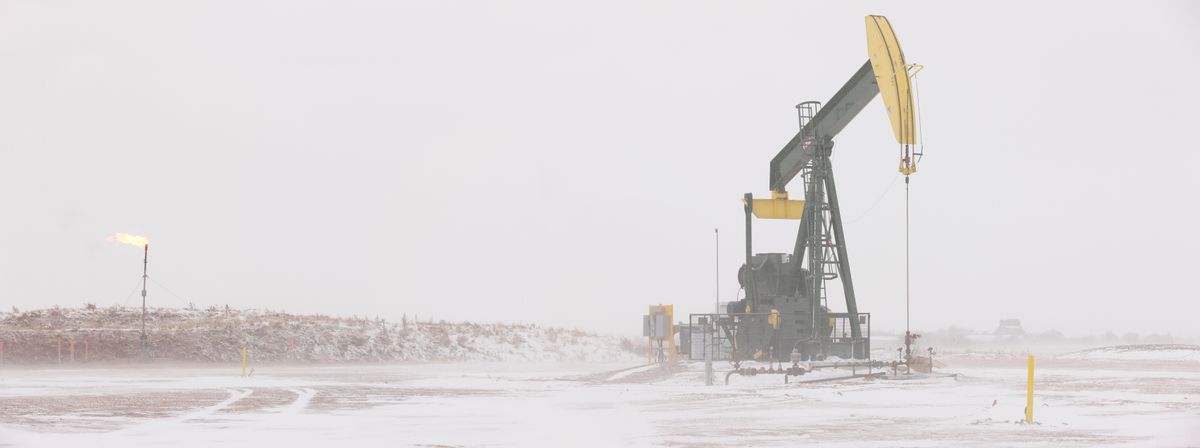Origin
An item about untapped oil reserves in the Bakken formation (which lies within portions of North Dakota, South Dakota, and Montana) appears to have been taken from a tout sheet intended to sell subscriptions to an investment newsletter.
"Just poking around the Internet recently, I simply "Googled" the search "Untapped U.S. Oil Reserves," and the result (like the current price of a gallon of gas - BLEW ME AWAY! Go ahead, take a minute and see for youself! Never mind, I'll share some of the highlights I found," the post read. (We've posted the entirety of the post at the bottom of this article.
It is vaguely true in the sense that geologists have estimated there is a good deal of undiscovered, technically recoverable oil in that area, and as the price of crude oil increases and the technology for extracting resources from formations like Bakken improves, that area becomes more and more economically viable as a source of oil for the U.S. However, the estimate of over 500 billion barrels of oil to be recovered from the Bakken formation is an overly optimistic one based on incomplete, outdated information.
A November 2006 report from the Energy Information Administration (EIA) stated that:
With new horizontal drilling and completion technology taken into account, the technically recoverable resource base for the entire Bakken Formation is potentially much larger. A draft study by the late organic geochemist Leigh Price provides estimates ranging from 271 to 503 billion barrels (mean of 413 billion) of potential resources in place. The study represents Dr. Price's work as it stood at the time of his death in August 2000. It was conducted while he was working for the USGS, but it did not receive a complete scientific peer review by the USGS and was not published as a USGS product. A new assessment of the entire basin, due out in about a year, will provide an updated USGS estimate of the technically recoverable oil resources in the Bakken Formation.
The U.S. Geological Survey (USGS) released its assessment of undiscovered oil resources in the Bakken formation in April 2008, and although it reported a 25-fold increase in the amount of oil that could be recovered from that area compared to its 1995 estimate, the 2008 USGS estimate was still far short of the 503 billion barrel volume cited above:
North Dakota and Montana have an estimated 3.0 to 4.3 billion barrels of undiscovered, technically recoverable oil in an area known as the Bakken Formation.
A U.S. Geological Survey assessment, released April 10, shows a 25-fold increase in the amount of oil that can be recovered compared to the agency's 1995 estimate of 151 million barrels of oil.
New geologic models applied to the Bakken Formation, advances in drilling and production technologies, and recent oil discoveries have resulted in these substantially larger technically recoverable oil volumes. About 105 million barrels of oil were produced from the Bakken Formation by the end of 2007.
The USGS estimate of 3.0 to 4.3 billion barrels of technically recoverable oil has a mean value of 3.65 billion barrels. Scientists conducted detailed studies in stratigraphy and structural geology and the modeling of petroleum geochemistry. They also combined their findings with historical exploration and production analyses to determine the undiscovered, technically recoverable oil estimates.
Certainly 3.65 billion barrels of recoverable oil is nothing to sneeze at, but a little perspective is in order. The U.S. currently imports an average of about 10 million barrels of oil per day (for a total of about 3.65 billion barrels of oil per year), so even if all the estimated undiscovered oil in the Bakken formation were extracted today, it would only be enough to wean the U.S. off of crude oil imports for one year. That's still a good thing, but it's not nearly "enough crude to fully fuel the American economy for 41 years straight" as claimed above.
As for the second part of the article, a 2005 study co-authored by James T. Bartis for the RAND Corporation (a nonprofit research organization) noted that estimates had placed upper range of shale oil resources to be found within the Green River Formation range of Colorado, Utah, and Wyoming at between 1.5 and 1.8 trillion barrels. However, the report also stated that not all of that oil was recoverable and offered a midpoint estimate of about 800 billion barrels of recoverable oil shale resources. Moreover, the report also noted that even under "high growth assumptions," an oil shale production level of 1 million barrels per day (about 10% of the amount of oil the U.S. currently imports daily) is "probably more than 20 years in the future," and depends upon scientists overcoming some substantial obstacles first:
But development of the resource hinges on overcoming economic, technical and environmental obstacles, Bartis said.
"No work has been done on the impacts of development and ways to mitigate those impacts," he said.
For example, shale development requires large expenditures of water and energy, produces air pollution and carbon emissions and leaves toxic byproducts that could endanger the environment.
According to news accounts, although new drilling techniques have greatly increased oil production in the Bakken Formation in recent years, as of February 2011 that region was still yielding less than half a million barrels per day.
Example: [Collected via e-mail, May 2008]
Just poking around the Internet recently, I simply "Googled" the search "Untapped U.S. Oil Reserves," and the result (like the current price of a gallon of gas - BLEW ME AWAY! Go ahead, take a minute and see for youself! Never mind, I'll share some of the highlights I found.
1. Ever heard of the Bakken Formation? GOOGLE it. I did, and again, BLEW my mind. The U.S. Geological Service issued a report in April ('08) that only scientists and oilmen/women knew was coming, but man was it big. It was a revised report (hadn't been updated since '95) on how much oil was in this area of the western 2/3 of North Dakota; western South Dakota; and extreme eastern Montana ... check THIS out:
The Bakken is the largest domestic oil discovery since Alaska's Prudhoe Bay, and has the potential to eliminate all American dependence on foreign oil. The Energy Information Administration (EIA) estimates it at 503 billion barrels. Even if just 10% of the oil is recoverable ... at $107 a barrel, we're looking at a resource base worth more than $5.3 trillion.
"When I first briefed legislators on this, you could practically see their jaws hit the floor. They had no idea." says Terry Johnson, the Montana Legislature's financial
analyst."This sizeable find is now the highest-producing onshore oil field found in the past 56 years," reports The Pittsburgh Post Gazette. It's a formation known as the Williston Basin, but is more commonly referred to as the "Bakken." And it stretches from Northern Montana, through North Dakota and into Canada. For years, U.S. oil exploration has been considered a dead end. Even the "Big Oil" companies gave up searching for major oil! wells decades ago. However, a recent technological breakthrough has opened up the Bakken's massive reserves... and we now have access of up to 500 billion barrels. And because this is light, sweet oil, those billions of barrels will cost Americans just $16 PER BARREL! That's enough crude to fully fuel the American economy for 41 years straight.
2. And if THAT didn't throw you on the floor, then this next one should - because it's from TWO YEARS AGO, people! U.S. Oil Discovery - Largest Reserve in the World! Stansberry Report Online - 4/20/2006 Hidden 1,000 feet beneath the surface of the Rocky Mountains lies the largest untapped oil reserve in the world is more than 2 TRILLION barrels. On August 8, 2005 President Bush mandated its extraction. What the!? They reported this stunning news: We have more oil inside our borders, than all the other proven reserves on earth. Here are the official estimates:
- 8-times as much oil as Saudi Arabia
- 18 times as much oil as Iraq
- 21 times as much oil as Kuwait
- 22 times as much oil as Iran
- 500 times as much oil as Yemen
and it's all right here in the Western United States.
HOW can this BE!? HOW can we NOT BE extracting this!? Because we've not DEMANDED Legislation to come out of Washington allowing its extraction,
that's why!James Bartis, lead researcher with the study says we've got more oil in this very compact area than the entire Middle East - more than 2 TRILLION barrels. Untapped. That's more than all the proven oil reserves of crude oil in the world today, reports The Denver Post.
Don't think "Big Oil" will drop its price - even with this find? Think again! It's all about the competitive marketplace, and if they can extract it (here) for less, they can afford to sell it for less - and if they DON'T, others will. It will come down - it has to.
Got your attention fired up yet? Hope so! Now, while you're thinking about it ... and hopefully P.O'd, do this:
3. Take 5-10 minutes and compose an e-mail; fax or good old-fashioned letter to our elected officials in Washington ... and their respected leaders. We'll start with them, and here's how you can send them your e-mail/fax, DEMANDING the immediate Legislation/an Energy PLAN that calls for tapping into these (OUR OWN!) Reserves, as well as allowing for the offshore drilling for OUR oil, in OUR offshore waters and Inter-continental shelf ... not to mention Alaska. Technology ain't what it used to be people (ever had arthroscopic surgery?). They can surgically extract OUR oil, and get us on the way to at least some measure of Energy independence.
Variations: A March 2011 version morphed the 2008 e-mail's claim "That's enough crude to fully fuel the American economy for 41 years straight" into "That's enough crude to fully fuel the American economy for 2041 years straight."
Sources
Fahey, Jonathan. "New Techniques Open Up New Fields." Detroit Free Press. 12 February 2011
Fialka, John J. "Wildcat Producer Sparks Oil Boom on Montana Plains." The Wall Street Journal. 5 April 2006.
Raabe, Steve "Study: Western U.S. Oil-Shale Reserves May Offer Relief in 20 Years." The Denver Post. 2 September 2005.

